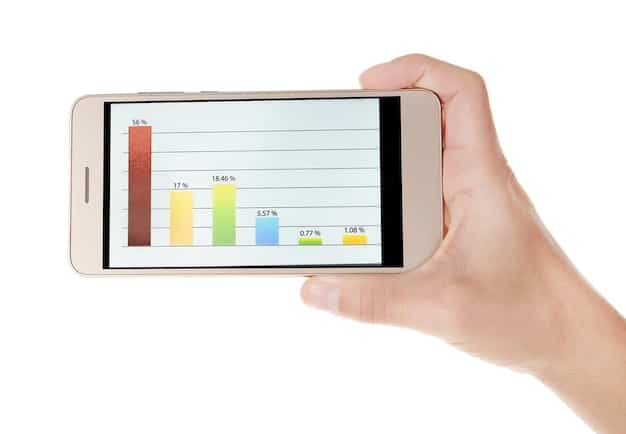Break Free: Overcoming Mindless Scrolling in 7 Days

Mindless scrolling can negatively impact mental health, productivity, and relationships; however, a 7-day plan incorporating mindful practices, setting limits, and finding alternative activities can help break the cycle.
Are you caught in an endless loop of **mindless scrolling**, feeling like you’re losing precious hours of your day? You’re not alone. Let’s explore how to break free from this cycle in just 7 days and reclaim your time and focus.
The Allure and Pitfalls of Mindless Scrolling
Mindless scrolling, that seemingly harmless activity of endlessly browsing through social media feeds or websites, has become a ubiquitous part of modern life. While it can offer a temporary escape or a quick source of information, it’s crucial to understand the allure and the potential pitfalls it presents.
The Draw of the Digital Rabbit Hole
The appeal of mindless scrolling lies in its accessibility and the instant gratification it provides. Social media platforms and websites are designed to be engaging, constantly feeding us with new and stimulating content. This constant stream of information triggers the release of dopamine, a neurotransmitter associated with pleasure and reward, making us feel good, at least momentarily.
Moreover, mindless scrolling can serve as a convenient way to avoid unpleasant tasks or emotions. It becomes a form of procrastination, allowing us to postpone dealing with more challenging or demanding aspects of our lives. The ease with which we can access and engage with digital content makes it a readily available and often irresistible escape.
The Negative Consequences of Excessive Scrolling
While the initial attraction of mindless scrolling may seem harmless, its long-term consequences can be detrimental to our well-being. Studies have shown that excessive screen time is linked to increased levels of anxiety and depression. The constant exposure to curated and often unrealistic portrayals of others’ lives can lead to feelings of inadequacy and low self-esteem.
- Reduced Productivity: Time spent scrolling is time lost on more productive activities, affecting work, studies, and personal projects.
- Sleep Disruption: The blue light emitted from screens can interfere with sleep patterns, leading to insomnia and fatigue.
- Social Isolation: Ironically, while social media aims to connect, excessive scrolling can lead to real-life social isolation and a decline in meaningful relationships.
In conclusion, understanding both the allure and the pitfalls of mindless scrolling is the first step towards breaking free from its grip. By recognizing the temporary gratification it offers and the potential negative consequences it entails, we can begin to make conscious choices to regain control of our time and well-being.
Day 1 & 2: Awareness and Setting Intentions
The first two days of breaking free from mindless scrolling are all about self-awareness and setting clear intentions. These initial steps are crucial for building a solid foundation for change and ensuring a higher likelihood of success.
Track Your Scrolling Habits
Start by tracking how much time you spend scrolling each day. Use the built-in screen time trackers on your smartphone or download a third-party app to monitor your usage. Pay attention to when, where, and why you tend to scroll the most. Are you scrolling out of boredom, stress, or habit?
Keep a journal or make notes on your phone to record your observations. Note the triggers that lead to scrolling, the platforms you use, and how you feel before, during, and after scrolling. This data will provide valuable insights into your scrolling patterns and help you identify areas for improvement.
Define Your Goals and Intentions
Once you have a clear understanding of your scrolling habits, it’s time to define your goals and intentions. What do you want to achieve by reducing your screen time? Do you want to be more productive, improve your mental health, or strengthen your relationships?
- Write Down Your Goals: Clearly articulate what you hope to achieve. For example, “I will reduce my social media usage to 30 minutes per day” or “I will spend more time engaging in hobbies I enjoy.”
- Visualize Success: Imagine yourself achieving your goals and picture the positive impact it will have on your life. This mental rehearsal can boost your motivation and commitment.
- Set Realistic Expectations: Start small and gradually increase the challenge. Trying to eliminate scrolling completely overnight is often unrealistic and can lead to frustration.
By the end of Day 2, you should have a solid understanding of your scrolling habits and a clear set of goals and intentions. This knowledge will empower you to take the next steps with confidence and determination.
Day 3 & 4: Implementing Boundaries and Limiting Triggers
Days 3 and 4 are focused on implementing boundaries and limiting the triggers that lead to mindless scrolling. This involves making conscious choices to create a more controlled digital environment and minimizing exposure to tempting stimuli.

Set Time Limits and Use App Restrictions
Take advantage of the built-in features on your smartphone to set time limits for specific apps. Both iOS and Android offer options to restrict usage and send notifications when you’ve reached your limit. These restrictions can help you stay within your intended boundaries and prevent excessive scrolling.
Consider using third-party apps that offer more advanced control over your screen time. These apps can provide detailed reports, block certain websites, and even schedule “downtime” when all non-essential apps are disabled. Experiment with different apps to find one that suits your needs and preferences.
Identify and Minimize Triggers
Pay attention to the situations, emotions, or locations that trigger your desire to scroll. Are you more likely to scroll when you’re bored, stressed, or waiting in line? Once you’ve identified your triggers, take steps to minimize your exposure to them.
- Turn Off Notifications: Constant notifications can be incredibly distracting and tempting. Disable notifications for social media apps and other platforms that encourage mindless scrolling.
- Create “No-Phone Zones”: Designate certain areas of your home, such as the bedroom or dining table, as phone-free zones. This can help you disconnect and focus on other activities.
- Replace Triggers: When you feel the urge to scroll, try replacing it with a healthier activity, such as reading, listening to music, or going for a walk.
By implementing boundaries and limiting triggers, you’re creating a more mindful and controlled digital environment. These changes will make it easier to resist the urge to scroll and stay focused on your goals.
Day 5 & 6: Finding Alternative Activities and Engaging Offline
Days 5 and 6 are dedicated to finding fulfilling alternative activities and engaging more fully in the offline world. This involves rediscovering hobbies, connecting with loved ones, and exploring new interests that can provide a sense of purpose and enjoyment.
Rediscover Hobbies and Interests
Think back to the activities you used to enjoy before mindless scrolling took over your life. What hobbies have you neglected? What interests have you put on hold? Now is the time to revisit those passions and rediscover the joy they bring.
If you’re struggling to remember what you used to enjoy, try experimenting with different activities until you find something that resonates with you. Consider joining a club or taking a class to learn a new skill or connect with like-minded individuals.
Engage in Real-Life Social Connections
Make an effort to spend more time with friends and family in the real world. Plan a dinner, go for a hike, or simply have a conversation without the distraction of your phone. These real-life social connections can provide a sense of belonging and support that is often lacking in online interactions.
- Schedule Social Activities: Make social time a priority by scheduling it in your calendar. Treat these appointments as important commitments that you won’t easily cancel.
- Be Present: When you’re with loved ones, put your phone away and focus on being fully present in the moment. Listen attentively, engage in meaningful conversations, and enjoy the shared experience.
- Volunteer: Volunteering can be a rewarding way to connect with others and make a positive impact on your community. Find a cause that you’re passionate about and offer your time and skills.
By finding alternative activities and engaging offline, you’re filling the void left by mindless scrolling with more fulfilling and meaningful experiences. These connections and activities will enrich your life and provide a sense of purpose that is far more satisfying than endless browsing.
Day 7: Reflection and Maintaining Momentum
Day 7 is a time for reflection and planning how to maintain the momentum you’ve gained throughout the week. This involves assessing your progress, identifying challenges, and setting strategies for continued success.

Assess Your Progress and Celebrate Wins
Take some time to review your progress over the past week. Have you successfully reduced your scrolling time? Have you found alternative activities that you enjoy? Have you noticed any improvements in your mood, productivity, or relationships?
Acknowledge your accomplishments and celebrate your wins, no matter how small they may seem. Give yourself credit for the effort you’ve put in and recognize the positive changes you’ve made.
Identify Challenges and Develop Strategies
Be honest with yourself about the challenges you’ve faced during the week. What triggers were difficult to resist? What strategies were less effective than you anticipated? Identify areas where you can improve and develop strategies to overcome those challenges.
- Adjust Your Goals: If your initial goals were too ambitious, consider adjusting them to be more realistic. It’s better to make gradual progress than to give up entirely.
- Seek Support: Talk to friends, family, or a therapist about your struggles. Having a support system can make it easier to stay on track and overcome setbacks.
- Be Kind to Yourself: Don’t beat yourself up if you slip up and scroll more than you intended. Forgive yourself and get back on track as soon as possible.
By reflecting on your progress, identifying challenges, and developing strategies, you’re setting yourself up for continued success in breaking free from mindless scrolling. Remember that this is an ongoing process, and it’s okay to make adjustments along the way.
Long-Term Strategies for a Mindful Digital Life
Breaking free from mindless scrolling is not a one-time event; it’s an ongoing process that requires sustained effort and mindful habits. Implementing long-term strategies is crucial for maintaining a healthy and balanced relationship with technology.
Practice Mindful Consumption of Digital Content
Be selective about the content you consume online. Unfollow accounts that make you feel negative or inadequate, and subscribe to sources that provide valuable information or inspiration. Consciously choose to engage with content that aligns with your values and supports your goals.
Take regular breaks from screens throughout the day. Get up, stretch, and move around to avoid eye strain and physical discomfort. Use these breaks as an opportunity to reconnect with your surroundings and engage in mindful activities.
Cultivate Offline Hobbies and Relationships
Continue to prioritize offline hobbies and relationships as a way to counter the allure of digital distractions. Make time for activities that bring you joy and connect you with others in meaningful ways. These offline pursuits will provide a sense of balance and fulfillment that is essential for a healthy digital life.
- Set Digital Boundaries: Establish clear boundaries for your technology use, such as no phones at the dinner table or no screens before bed. Communicate these boundaries to your family and friends to ensure they are respected.
- Regular Digital Detoxes: Plan regular digital detoxes, where you intentionally disconnect from all technology for a set period of time. This can be a weekend, a day, or even just a few hours each week.
- Stay Informed: Stay informed about the latest research on the impact of technology on mental health and well-being. This knowledge will empower you to make informed choices about your technology use and advocate for a more mindful digital culture.
By implementing these long-term strategies, you can create a digital life that is both enriching and balanced. Remember that technology is a tool, and it should serve you, not the other way around. By consciously choosing how and when you engage with technology, you can reclaim your time, focus, and well-being.
| Key Point | Brief Description |
|---|---|
| 📱 Awareness | Track scrolling to identify habits and triggers. |
| ⏰ Time Limits | Set daily limits on apps to reduce screen time. |
| 🧘 Alternative Activities | Engage in hobbies and offline social connections. |
| 💡 Reflection | Assess progress and adjust strategies for long-term success. |
FAQ
▼
Signs include losing track of time, feeling empty after scrolling, and using it to avoid responsibilities. You might also feel anxious or irritable when you can’t scroll.
▼
It can lead to increased anxiety, depression, and feelings of inadequacy due to constant exposure to curated online content and comparisons with others’ lives.
▼
Consider reading, exercising, spending time in nature, engaging in hobbies, or connecting with friends and family offline. These activities offer more fulfillment.
▼
Use built-in phone features or third-party apps to establish daily limits for specific apps. Start with a realistic reduction and gradually decrease the time allowed.
▼
Don’t be too hard on yourself. Recognize it as a temporary setback, learn from the trigger, and recommit to your goals immediately. Consistency is key.
Conclusion
Breaking the cycle of **mindless scrolling** is a journey that requires awareness, intention, and consistent effort. By implementing the strategies outlined in this 7-day plan and cultivating a mindful approach to technology, you can reclaim your time, focus, and well-being, creating a more fulfilling and balanced life.





